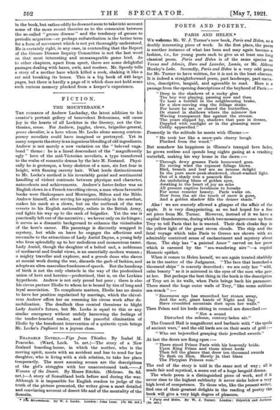SPORT IN SCOTLAND.*
Ma. SPBEDY'S book is the result of a long life spent in surround. bags ideal for his purpose. He was born in 1846 on the estate of Ladykirk on the Tweed, where he became kennel-boy at the age of twelve. Before he left school he had disobeyed orders by sliding on the Tweed, when he fell into deep water and was pulled out by the hair of his head. As kennel-boy he persuaded the keepers to let him join in a badger-hunt, and to cure his per- sistency they left him sitting alone at night over a badger's earth. He was terrified, but came home at three in the morning carrying a badger in a sack. At seventeen he was promoted to be under-keeper; at twenty-two he was a head-keeper; later he became factor at Craigmillar Castle, and through all these years to the present day his chief interest in life has been sport with rod and gun, but particularly the natural history of his birds and beasts and fish. Here are fourteen chapters ranging through every aspect of game shooting ; we get a practical gamekeeper's experience of the habits of the so-called ground vermin, from badgers to adders ; advice on the taking of a shooting estate ; a chapter on salmon-fishing, and many excellent pages on grouse, partridges, pheasants, deer-stalking,and so on. We are glad to notice that Mr. Speedy condemns the practice of buying grouse to re-stook moors—a method as absurd as it is unsportsmanlike. There are men who make a living, if not a large income, out of buying or renting a small piece of ground near some productive stretch of moorland, and then netting the grouse as they fly from their neighbour's moors. Those who buy these grouse must be well aware that they are as truly poached as if they were actually taken on another man's ground, but the traffic in live grouse—which can be, strictly speaking, as legal as many other mean and unworthy businesses—still continues. If there were no demand, of course, the trade would cease, but there are ignorant owners or tenants of grouse moors who suppose that a wild and wandering bird like the grouse can be " put down " on a moor as easily as pheasants in a covert. Mr. Speedy's chapter on grouse is one of the beet • The Natural History of Sport in Scotland with Rod and Gun. By Torn Speedy.
With illustrations by ISent.-Commandar J. G. London : Blackwood.
Ms. SSW
in the book, but rather oddly he does not seem to take into account some of the more recent theories as to the connexion between the so-called " grouse disease " and the tendency of grouse to periodic migration—or perhaps redistribution is the better term for a form of movement which is not yet thoroughly understood. He is certainly right, in any case, in contending that the Report of the Grouse Disease Inquiry Committee is not the last word on that most interesting and unmanageable game bird. As to other chapters, apart from sport, there are some delightful passages dealing with hares, owls, and roedeer. Mr. Speedy tells a story of a mother hare which killed a rook, shaking it like a rat and breaking its bones. This is a big book of 440 large pages, but there is hardly a page of it which does not hold some such curious memory plucked from a keeper's experience.



































 Previous page
Previous page